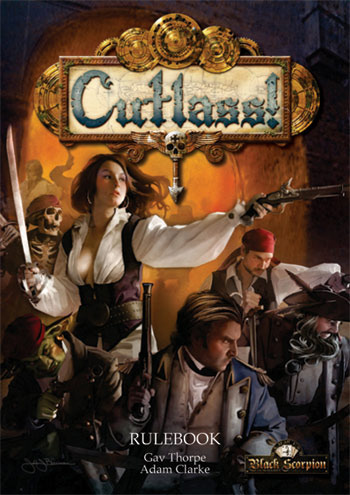Arr, Me Hearties!
As I've said in several interviews, when I left the GW Design Studio, I swapped a day job of games design and spare-time fiction writing for full-time writing and spare-time games design. The first of my efforts is soon to see the light of day, and I'm very excited about this.
The Cutlass! rules allow players to collect a band of fighters and battle for control of a strange island in the Carribean. These are fantasy pirates, so as well as Pirates, Privateers and Royal Navy gangs you can also opt for Orcs and Goblins, Dwarfs, Undead and Elves. You can find out more at the Black Scorpion website so I won't repeat that here. Instead I'm going to write a bit about how the game came into being and how I set about designing the core rules.
How it Happened
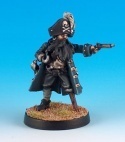
Black Jack Davey
Last year I went with a friend to a wargames show – Triples in Sheffield, I think, but I might be mistaken. Amongst all the lovely wargaming goodness, Carl and I found Adam Clarke at his Black Scorpion stand late in the day. I had been determined to purchase some terrain for another rules set I am working on, but had failed miserably to find anything I liked, so I had some money burning a hole in my pocket. Seeing Adam's miniatures in the flesh stirred old 'gotta have them' feelings, so Carl and I exchanged a look and pretty much decided on the spot that some fantasy pirate fun was to be had.
Wind forwards a few months, and I was delighted to be contacted by Adam, who was looking for someone to pen a set of rules to accompany his lovely miniatures. I was up for it, as they say, and after Adam outlined roughly what he was looking for, I set to scribbling down some ideas, pushing some soldiers around on the dining table and rolling dice to see if the basic system I had in mind would work.
Objectives
A warbands-level game, allowing for forces of between 10 and 30 (ish) models.
Basic rules that can be developed for different settings – mix of close combat and ranged fire tactics to cope with expansions into pirates and cowboys initially.
Dining table-sized playing area.
Fastplay rules, allowing for lunchtime gaming or several games in a session.
Campaign play and options for creating 'off the peg' experienced warbands for pick-up play.
Easily expandable for new miniatures releases.
The Main Rules
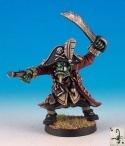
Orc Admiral
This was the bullet point brief, and though a few things have morphed a little bit (the standard table is 4′ x 4′ now, small enough to put a board on a dining table) I've pretty much stuck to this. My primary goal was to design a system that allowed the players to interact throughout play, rather than having to wait out their opponent's turn. Initially I included a lot of opposed dice rolls (that is, both players roll against each other to determine success or failure of an action) but this proved a bit too cumbersome for more than a handful of models, so I streamlined my ideas a little bit after the first few solitary test sessions (yes, I started out playing with myself…).
Something else I had said in my proposal summed up what I was trying to achieve.
I see this as providing a game that recreates the swirling, sometimes anarchic combat of a pirate raid or gunfight. Rather than players simply taking turns to resolve their actions, the system will include a flowing 'reaction' dynamic that allows the players to respond to and interrupt their opponents, allowing the fight to ebb and flow from one side to the other.
I've always been a keen fan of Jervis Johnson's Blood Bowl rules, and one of the major features in that system is the 'Turnover' rule, which means if one of your team makes a mess of things, your turn ends and your opponent's turn starts. The Turnover idea has stuck in my head as one of the best things a games system can have, because it makes players face tough decisions and really rewards proper planning but also allows risk-taking.
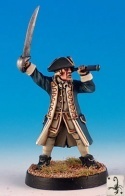
Navy Captain
As I'm sure most games designers do, I am constantly thinking up neat little mechanics and systems, making notes about them and then putting them to one side until they find an appropriate venue. One such system had been bugging me for the last couple of years, and Cutlass! seemed a great place to bring it into being. The central game revolves around using different dice to represent the skills of the fighters on the tabletop. This ties in with the opposed dice rolls idea, so while a rookie might only have a four-sided die to roll, a veteran warrior might roll an eight-sided die for the same test. To even things out a little, I made these dice rolls 'open-ended', which means if a player scores the highest possible result (a 4 on a four-sided die, for example) they can roll again and add the next score on to the total. This creates some interesting dynamics, maths-wise, because a die with more sides can score higher on a single roll but has less probability of scoring the maximum result. This serves to smooth out the differences between the skill levels and I think works rather well.
Encounters
As well as the nuts and bolts of running around and fighting, Adam was very much inspired by other skirmish-level games that allow the players to run a campaign, linking their games together so that their fighter suffer injuries, get better, earn new skills and so on. As part of this, I was tasked with designing the scenario and campaign systems. From my proposal:
Games will be scenario-based, with each side having its own objectives to achieve. Rather than players being thrown into a random situation, each will choose what they want to do and the resultant match of objectives forms the scenario. The players will then have to form their tactics around achieving their goals whilst hampering the enemy.The scenarios will have a narrative dynamic. That's to say, the achievement of objectives will be more important than simply killing the enemy. These will include searching for loot, kidnapping or rescuing an individual, attacking an enemy camp, pursuits and ambushes and so on.
I was very much of the mind to let the miniatures be a vehicle for telling a story, and so the Encounters I've devised provide a framework for how the battling gangs are set up, and what they are fighting for, but leave lots of room for the players to add their own narrative.
These scenarios will be created without any setting detail, which can be layered on later. For example, in one setting the 'loot' scenario might be raiding a coastal village and in another a bank robbery. One of the scenarios will definitely be a bar brawl of some kind…
Campaigns
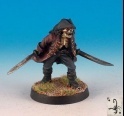
Undead Captain
For the campaign, I was very keen to include lot of the usual stuff: injuries, experience, new equipment. To provide some wrinkles, there is a recruitment system that offers up random new additions to the gang; rather than simply spend money or points on getting who they want, the pllayer (as leadr of the gang) has to pick and choose from those who offer their services between each Encounter. On top of new members and weapons, the players can also upgrade their gang hideout or barracks, giving them something other than just fighters to spend their their loot on.
This harked back to memories of the Design Studio Necromunda campaign many years ago, which culminated in an alliance of gangs taking on the might of Andy Chambers' Dog Soldiers in an assault on their Underhive lair. It was great fun to play and has stuck with me, so when I devised the Cutlass! campaign system, I wanted something with a similar feel. For this reason, there are opportunities to raid each other's hideouts, either just for the giggles and swag, or to rescue prisoners taken from your gang.
On top of that, some campaign systems have no obvious end point. The players keep playing and the gangs keep getting bigger and more powerful, until everyone decides to take a break. In Cutlass! there is more structure to the campaign endgame. When a gang gets to a certain size or fame/ infamy, it triggers 'The Final Reckoning'. This works like a knock-out tournament competition, whittling away the participants until two gangs remain to battle for control of the island. It gives the campaign more of a narrative and sense of direction, as players realise that they or someone else is close to the tipping point, maybe wanting to get a couple more games in to beef up their gang before the fight to the death starts!
Get Playing
So, nearly a year after drooling over Adam's gorgeous miniatures, I now have a set of rules we can use them with. If you want to find out more and stay up-to-date with the latest Cutlass! news, you can follow Black Scorpion and the Cutlass! game on Facebook.
Up for a game, Carl?

Pirate Girls
All images (c) Black Scorpion Miniatures.









